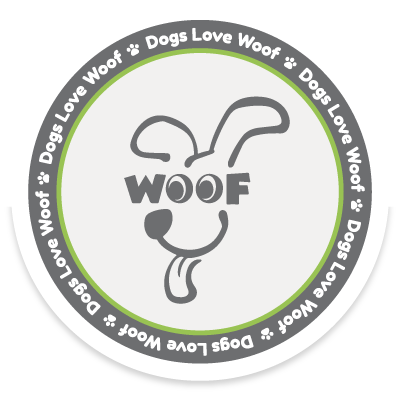The other night this collar sparked an idea.
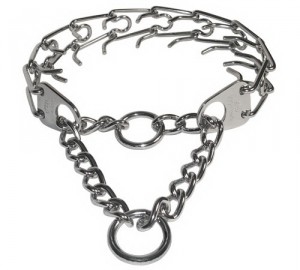
I was talking to a WOOF client (hi Michelle!) while one of our staff members (hi Victoria!) was in back struggling with this prong collar (hello … collar).
This collar. Not our favorite.


 🙁 😥 🙁
🙁 😥 🙁
They get tangled. Links fall off. They hurt your fingers. They’re really hard to put on an excited dog who knows his parents are here and can’twaittogetoutthere! But mainly, they just don’t work very well.
It’s not a particularly attractive collar, or user-friendly. And yet I see folks using it all the time. In fact, I know a lot of smart (especially strong-fingered) people who use this collar. And I get it – it’s supposed to discourage dogs from pulling. And when you have a dog who pulls, you are willing to try anything.

Even a collar that looks like this –

Instead of, say, this –

Or (if you are gluten-intolerant, even for decorations) this –

So I asked the client – “Do you like this collar?” And you know what she said? “No, not really!” And we had a nice laugh and discussed some alternatives.
Sigh.
My take-away from this conversation is that people buy a collar that’s supposed to perform a certain way and end up keeping it even if it doesn’t perform as advertised. Maybe blaming themselves that they’re not using it right, or their dog is just extra-determined to stick with the negative behavior that the collar was supposed to discourage.
And that makes me sad because a good product – used correctly, sure, sure – should work! But I’ve never seen a dog respond particularly well to the prong collar. (If you have, please do tell in the comment section!) I see them pulling anyway, digging those medieval-looking claws into their skin and dragging their owner along in the process.
What I mostly see with this collar is frustrated dogs, frustrated parents and – hello WOOFers! – frustrated dog professionals trying to deal with the darn thing.
Let’s look at it again, just for fun.

You bad old collar, you.
How do we end up with the leashes and collars we have? Maybe it’s a combination of what’s familiar, what we’ve been told to use by “experts” and what’s just convenient for us.
But how SHOULD we choose them? Let me count the ways.

I’m basing the following on my personal experiences with leashes and collars (which adds up to a lot if you count all the dogs and leash-collar combos I’ve dealt with in my career) – plus a little online research to make sure I’m giving you sound advice.
Having said all this, I want to make one thing clear: use the leash and collar that works for you. Even if it’s the prong collar of our aforementioned nightmares – it’s okay! We’ll deal with it if that’s what works for your dog.
Step one – what are your dog’s physical characteristics?
What does your dog look like? Take a good look.

Is your dog BIG?
 little?
little?

Does she have curly hair?

Wiry hair?

Skin folds? (And a flat, super-adorable face?)

All this can factor into your collar choice.
Step two: what is your dog’s walking style?
Is he a puller, eager to get to the next thing? A slow-poke, meandering past ever flower, sniffing everything? An escape artist, who can’t wait to slip out of his collar and run free?
A perfect gentleman, ideal in every way?
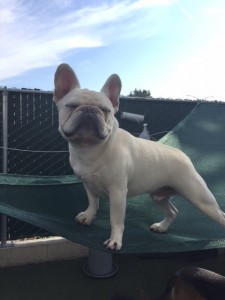
Oh, Rocky.
Now keep all those details in mind as you move on to –
Step three: knowing your options.
I know when you go to the pet store it’s pretty overwhelming.
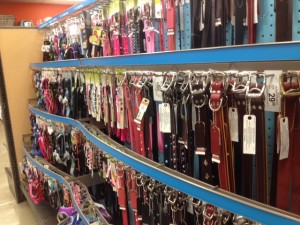
(I was mesmerized by this display today, and I was only in there for dog food.)
Even though it looks like there are endless options, there are really only a few kinds of collars – just with endless variations on those kinds. Let’s just focus on the basic types of collars.
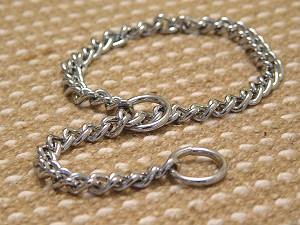
The classic choke chain. (The precursor to the prong collar, I think?) I remember these were used a lot when I was a kid (think 80s & 90s) but I don’t see them around much anymore. Although when you say “collar,” this is what some people will always picture. (Which is one of the main factors in how people choose their collars – and dog breeds, for that matter – just purely from what’s familiar/iconic for them.)
This is a fine collar in my book. The beauty of it is that it self-regulates. If your dog is pulling, it tightens. If your dog lets up, it loosens. It can be a great tool for training if you know how to use them judiciously.
But quite honestly my experience with this collar is that a dog who is determined to pull will pull (and pull and pull), choking himself silly. And also, if it’s not put on correctly, it doesn’t “give” – once it tightens, it stays tight. So I would only recommend this to someone who really knows how to use it and makes sure it’s not constantly choking their dog with no relief.

Back to the prong collar, and its kissing cousins –
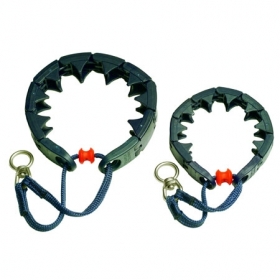
The plastic spiky prong collar (I named this myself)
This prong collar s a little easier to put on and manage, since the prongs aren’t detachable, but it poses all the same issues. If a dog pulls, the discomfort of the plastic spikes often doesn’t seem to stop them. A dog will pull those spikes right into his throat and not seem to understand the correlation between stopping pulling and relief. So, unless your dog responds to the pressure of the collar by letting up, I’m not a big fan.
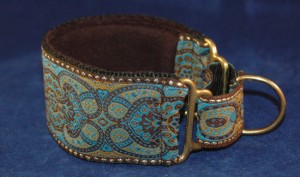 A variation on your basic martingale collar. I’ve come to learn that “martingale”is just a fancy word for collars that don’t have an opening and closing mechanism – they expand to fit over the dog’s neck and the pulling action of the leash shortens the collar’s girth to fit tightly around the neck. These are good for dogs who try to slip out of their collars – because the harder they pull, the tighter the collar gets.
A variation on your basic martingale collar. I’ve come to learn that “martingale”is just a fancy word for collars that don’t have an opening and closing mechanism – they expand to fit over the dog’s neck and the pulling action of the leash shortens the collar’s girth to fit tightly around the neck. These are good for dogs who try to slip out of their collars – because the harder they pull, the tighter the collar gets.

This is the most classic, basic collar. (I call this the Tiny Human Belt Collar.) It has the classic belt-like closure. I like this collar a lot because it does its job without too much user-education needed. I dislike having to put this kind of collar on a really excited dog, because getting the closure done properly requires the dog to be still. Too often, it’s put on using the wrong hole – either too loose or too tight – so your dog’s going to slip right out of it in the parking lot or you’re choking the poor thing.

This is the basic non-leather collar with a really convenient snap closure. This is definitely the collar I see most at WOOF and I really like this collar. You adjust it once and it stays the right size. It’s really easy to snap on a wiggly dog. It’s comfortable for dogs and they come in a lot of cute prints – I especially like the ones where you can stitch the dog’s name and phone number right on the collar. Also a nice option for quick ID for a lost dog without the jingly-jangly annoyance of tags.
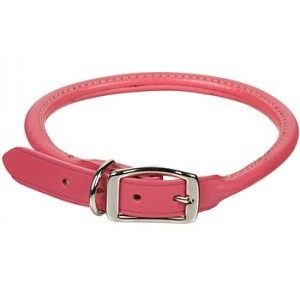
Here’s your basic rolled collar. This is ideal for dogs with thick, double coats (like Bernese Mountain Dogs, Newfoundlands, St. Bernards etc) – the rolled material nestles gently inside the thick coat instead of mashing it down like a regular collar, causing tangles to form underneath and possible discomfort. (If you have a thick-coated dog, make sure you are constantly checking for matts – you can’t always see them, but you can feel them if you run your hand down the dog’s hair. They are really deep tangles that sit close to the skin and they hurt because the hair in the tangle is pulling on the hair growing out of the skin.)
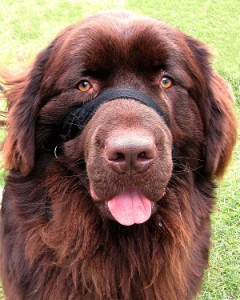
Here we see my personal favorite for dogs who pull: the head collar. (Also called the Halti and the Gentle Leader, and I’m sure other things.) I love this ingenious piece of equipment! It uses the same philosophy horse owners have been using for decades: an animal will stop pulling if they feel pressure on their nose, which is very sensitive. (Ever wondered why people lead bulls around with nose rings? This is a much more humane version of that idea.)
I had a Newfie named Clyde who was an angel … in his Halti. In fact, soon after buying the Halti I would only have to show him that I was putting it on and he knew what his limits were, and he didn’t even try to pull. So if you have a puller, try the head collar! I highly recommend it.
Then we get to the harnesses, which is by and far the biggest trend I’ve seen lately, especially among little dogs.

Harness proponents like them because they don’t put any pressure on the dog’s larynx. When the dog pulls, they are getting an even distribution of weight along their chest. That’s a good thing physiologically – especially for our flat-faced breeds like Pugs or Bulldogs, who already have a hard time breathing without a potentially crushed trachea.
But training-wise, it’s not such a good thing. If a pulling dog suffers zero discomfort when pulling, then guess what? They’ll continue to pull! In fact, some dog experts think dogs actually get some pleasure out of the act of pulling, so you’re only making it more “pleasurable” by using a harness.
Here’s a good article on whether to choose a collar or a harness. (I like a harness for little dogs, or flat-faced dogs, because their anatomy is a lot more delicate than a bigger dog and I think the protection a halter offers far outweighs the training downside. Also because a Chihuahua pulling is a lot less problematic than a Great Dane pulling…)
So, here we are knowing all about our dog and what is available. Let’s consider some example and think about what kind of equipment would be best in each scenario:
You have a Pug who loves to pull and has larygeal paralysis?
– try a HARNESS!
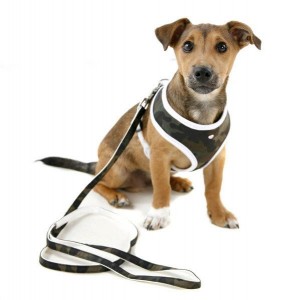
You have a Bernese Mountain Dog who doesn’t pull at all and goes to the groomer rarely (you groom him at home)?
– try a ROLLED COLLAR!

You have that Bernese Mountain Dog’s brother who pulls like the dickens?

– try a HALTI!
You have a sweet-natured and gigantic Mastiff who doesn’t pull but is notorious for escaping out of his collar?

– try a martingale-style big, flat cloth collar!
And if his fur matts up under that thick collar? (This one is a toughie…)

– try a martingale ROLLED collar!
I use the word “try” deliberately – make sure you TRY OUT a few things before settling on something that really isn’t working that great for you. If you can’t find a nice pet store employee to let you try a few things on your dog and walk them around the store, go to another store. Any good establishment will be willing to help you find the right equipment.
As far as leashes go, it’s much simpler. Just get a leash no longer than six feet. I don’t care what the material is or the style.
But never, ever, get one of these monsters.

The dreaded retractable leash.
I don’t know who likes this leash but it’s not any pet professional I’ve ever talked to. The problem is you have zero control over your dog. The locking mechanism that limits the amount of “leash” (which is really just a thin piece of rope material that can lacerate the heck out of human skin) is useless – it jams, it doesn’t work, or it lets out feet upon feet of leash when you are trying to reign in the dog.
Our ultimate nightmare combination:


Just don’t get one of these. They’re so problematic, WOOF has “outlawed” them in our facility (although I still see one or two sneak in…) If you want your dog to have more room to run, find a good off-leash area. (Or bring them to WOOF!)
If you already have one of these, throw it away and get a regular leash. Please.
A leash and collar have to do two things: work for the dog and work for the owner. If it’s falling short in either area, I guarantee there’s something else on the market that will be a vast improvement.
And when you find your perfect leash and collar, your dog will look deeply into your eyes, give you a big kiss, and say, thank you, wonderful mommy. You’ve made my dreams come true.
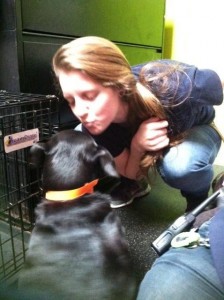
Not really. She’ll jump all over you and say, let’s go for a walk, fool!
What kind of collar works for you?
